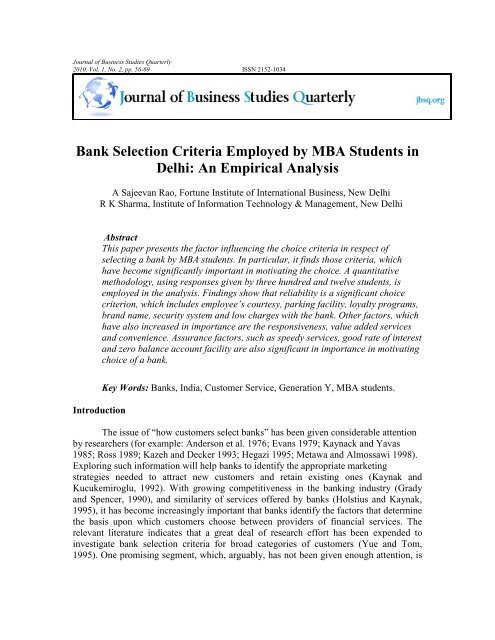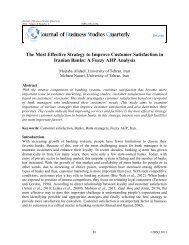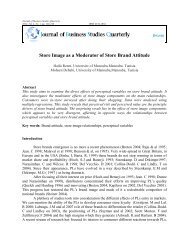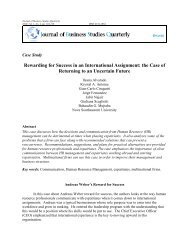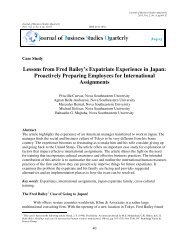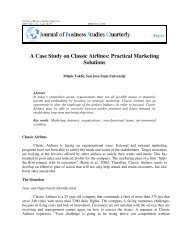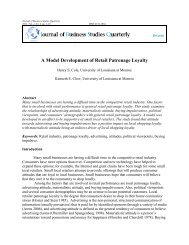Bank Selection Criteria Employed by MBA Students in Delhi
Bank Selection Criteria Employed by MBA Students in Delhi
Bank Selection Criteria Employed by MBA Students in Delhi
You also want an ePaper? Increase the reach of your titles
YUMPU automatically turns print PDFs into web optimized ePapers that Google loves.
Journal of Bus<strong>in</strong>ess Studies Quarterly<br />
2010, Vol. 1, No. 2, pp. 56-69 ISSN 2152-1034<br />
<strong>Bank</strong> <strong>Selection</strong> <strong>Criteria</strong> <strong>Employed</strong> <strong>by</strong> <strong>MBA</strong> <strong>Students</strong> <strong>in</strong><br />
<strong>Delhi</strong>: An Empirical Analysis<br />
A Sajeevan Rao, Fortune Institute of International Bus<strong>in</strong>ess, New <strong>Delhi</strong><br />
R K Sharma, Institute of Information Technology & Management, New <strong>Delhi</strong><br />
Introduction<br />
Abstract<br />
This paper presents the factor <strong>in</strong>fluenc<strong>in</strong>g the choice criteria <strong>in</strong> respect of<br />
select<strong>in</strong>g a bank <strong>by</strong> <strong>MBA</strong> students. In particular, it f<strong>in</strong>ds those criteria, which<br />
have become significantly important <strong>in</strong> motivat<strong>in</strong>g the choice. A quantitative<br />
methodology, us<strong>in</strong>g responses given <strong>by</strong> three hundred and twelve students, is<br />
employed <strong>in</strong> the analysis. F<strong>in</strong>d<strong>in</strong>gs show that reliability is a significant choice<br />
criterion, which <strong>in</strong>cludes employee’s courtesy, park<strong>in</strong>g facility, loyalty programs,<br />
brand name, security system and low charges with the bank. Other factors, which<br />
have also <strong>in</strong>creased <strong>in</strong> importance are the responsiveness, value added services<br />
and convenience. Assurance factors, such as speedy services, good rate of <strong>in</strong>terest<br />
and zero balance account facility are also significant <strong>in</strong> importance <strong>in</strong> motivat<strong>in</strong>g<br />
choice of a bank.<br />
Key Words: <strong>Bank</strong>s, India, Customer Service, Generation Y, <strong>MBA</strong> students.<br />
The issue of “how customers select banks” has been given considerable attention<br />
<strong>by</strong> researchers (for example: Anderson et al. 1976; Evans 1979; Kaynack and Yavas<br />
1985; Ross 1989; Kazeh and Decker 1993; Hegazi 1995; Metawa and Almossawi 1998).<br />
Explor<strong>in</strong>g such <strong>in</strong>formation will help banks to identify the appropriate market<strong>in</strong>g<br />
strategies needed to attract new customers and reta<strong>in</strong> exist<strong>in</strong>g ones (Kaynak and<br />
Kucukemiroglu, 1992). With grow<strong>in</strong>g competitiveness <strong>in</strong> the bank<strong>in</strong>g <strong>in</strong>dustry (Grady<br />
and Spencer, 1990), and similarity of services offered <strong>by</strong> banks (Holstius and Kaynak,<br />
1995), it has become <strong>in</strong>creas<strong>in</strong>gly important that banks identify the factors that determ<strong>in</strong>e<br />
the basis upon which customers choose between providers of f<strong>in</strong>ancial services. The<br />
relevant literature <strong>in</strong>dicates that a great deal of research effort has been expended to<br />
<strong>in</strong>vestigate bank selection criteria for broad categories of customers (Yue and Tom,<br />
1995). One promis<strong>in</strong>g segment, which, arguably, has not been given enough attention, is
© A Sajeevan Rao and R K Sharma<br />
the younger age group. <strong>Bank</strong>s which are plann<strong>in</strong>g to cultivate this vibrant market segment<br />
must understand how <strong>in</strong>dividuals belong<strong>in</strong>g to such segments select their banks.<br />
A review of literature also <strong>in</strong>dicates that studies related to bank selection criteria have<br />
been ma<strong>in</strong>ly conducted <strong>in</strong> the USA and some European countries (Denton and Chan,<br />
1991). Although such studies have contributed substantially to the literature on bank<br />
selection, their f<strong>in</strong>d<strong>in</strong>gs may not be applicable to other countries, due to differences <strong>in</strong><br />
cultural, economic and legal environments. A set of determ<strong>in</strong>ant factors that have a<br />
significant role <strong>in</strong> bank selection <strong>in</strong> one nation may prove to be <strong>in</strong>significant <strong>in</strong> another.<br />
This article focuses on study<strong>in</strong>g the bank selection criteria be<strong>in</strong>g employed <strong>by</strong> a<br />
crucial segment (i.e. <strong>MBA</strong> students) of potential customers (aged 21-28) <strong>in</strong> India.<br />
In India, the growth was very slow and banks also experienced periodic failures between<br />
1913 and 1948. There were approximately 1100 banks, mostly small. To streaml<strong>in</strong>e the<br />
function<strong>in</strong>g and activities of commercial banks, the Government of India came up with<br />
the <strong>Bank</strong><strong>in</strong>g Companies Act, 1949 which was later changed to <strong>Bank</strong><strong>in</strong>g Regulation Act<br />
1949 as per amend<strong>in</strong>g Act of 1965 (Act No. 23 of 1965). Reserve <strong>Bank</strong> of India was<br />
vested with extensive powers for the supervision of bank<strong>in</strong>g <strong>in</strong> India as the Central<br />
<strong>Bank</strong><strong>in</strong>g Authority.<br />
Dur<strong>in</strong>g those days, public had lesser confidence <strong>in</strong> the banks. As an aftermath<br />
deposit mobilization was slow. Earlier sav<strong>in</strong>gs bank facility provided <strong>by</strong> the Postal<br />
department was comparatively safer. Moreover, funds were largely given to traders.<br />
Government took major steps <strong>in</strong> this Indian <strong>Bank</strong><strong>in</strong>g Sector Reform after <strong>in</strong>dependence.<br />
In 1955, it nationalized Imperial <strong>Bank</strong> of India with extensive bank<strong>in</strong>g facilities on a<br />
large scale especially <strong>in</strong> rural and semi-urban areas. It formed State <strong>Bank</strong> of India to act<br />
as the pr<strong>in</strong>cipal agent of RBI and to handle bank<strong>in</strong>g transactions of the Union and State<br />
Governments all over the country. Seven banks form<strong>in</strong>g subsidiary of State <strong>Bank</strong> of India<br />
was nationalized <strong>in</strong> 1960. On 19th July, 1969, major process of nationalization was<br />
carried out. It was the effort of the then Prime M<strong>in</strong>ister of India, Mrs. Indira Gandhi. 14<br />
major commercial banks <strong>in</strong> the country were nationalized.<br />
Second phase of nationalization Indian <strong>Bank</strong><strong>in</strong>g Sector Reform was carried out <strong>in</strong> 1980<br />
with seven more banks. This step brought 80% of the bank<strong>in</strong>g segment <strong>in</strong> India under<br />
Government ownership.<br />
Major development occurred <strong>in</strong> 1991, under the chairmanship of M Narasimham<br />
Rao, when a committee was set up <strong>by</strong> his name, which worked for the liberalization of<br />
bank<strong>in</strong>g practices. The country is flooded with foreign banks and their ATM stations.<br />
Efforts are be<strong>in</strong>g put to give a satisfactory service to customers. Phone bank<strong>in</strong>g and net<br />
bank<strong>in</strong>g were <strong>in</strong>troduced. The entire system became more convenient and swift. Time is<br />
given more importance than money.<br />
Over the years, banks are also customiz<strong>in</strong>g themselves. The Indian bank<strong>in</strong>g<br />
<strong>in</strong>dustry is pass<strong>in</strong>g through a phase of customers market. The customers have more<br />
choices <strong>in</strong> choos<strong>in</strong>g their banks. A competition has been established with<strong>in</strong> the banks<br />
operat<strong>in</strong>g <strong>in</strong> India. With stiff competition and advancement of technology, the services<br />
provided <strong>by</strong> banks have become more easy and convenient.<br />
In this paper, the researchers have tried to study attributes a bank has to provide <strong>in</strong> Indian<br />
banks or <strong>in</strong> other words try to assess what are the variables that attract a <strong>MBA</strong> student to<br />
choose bank<strong>in</strong>g services.<br />
57
Literature Review<br />
58<br />
Journal of Bus<strong>in</strong>ess Studies Quarterly<br />
2010, Vol. 1, No. 2, pp. 56-69<br />
Thomas Foscht, Judith Schloffer, Cesar Maloles III, Swee L. Chia (2009) found<br />
the differences among the three age groups conta<strong>in</strong>ed <strong>in</strong> Generation Y <strong>in</strong> terms of their<br />
sources of <strong>in</strong>formation, f<strong>in</strong>ancial services used, likelihood of switch<strong>in</strong>g, and number of<br />
banks utilized. In addition, determ<strong>in</strong>ants of satisfaction, loyalty, and behavioral <strong>in</strong>tention<br />
are primarily affected <strong>by</strong> satisfaction with employees and services rendered. There results<br />
<strong>in</strong>dicated that as young people reach certa<strong>in</strong> milestones, their needs become more<br />
multifaceted. Consequently, the determ<strong>in</strong>ants of satisfaction have also changed. A study<br />
conducted <strong>by</strong> Mamunur Rashid, M. Kabir Hassan (2009) <strong>in</strong> Bangladesh <strong>in</strong> six full<br />
fledged Islamic banks found non-Islamic factors such as Corporal efficiency, Core-<br />
<strong>Bank</strong><strong>in</strong>g Services, Confidence, etc. were given higher weights <strong>by</strong> majority of the<br />
respondents. The report recommends <strong>in</strong>troduc<strong>in</strong>g complete E-<strong>Bank</strong><strong>in</strong>g solution, to<br />
<strong>in</strong>crease advanced market<strong>in</strong>g efforts and to hire experienced human resources for better<br />
Islamic <strong>Bank</strong><strong>in</strong>g activities <strong>in</strong> Bangladesh.<br />
Charles Blankson , Ogenyi Ejye Omar , Julian M<strong>in</strong>g-Sung Cheng (2009)<br />
identified four key factors - convenience, competence, recommendation <strong>by</strong> parents, and<br />
free bank<strong>in</strong>g and/or no bank charges - to be consistent across the two economies. The<br />
recommendation of the study is that <strong>in</strong> the context of an open and liberalized market<br />
environment, retail bank market<strong>in</strong>g strategies should be standardized irrespective of the<br />
national development stage. It concludes that retail bank managers particularly <strong>in</strong><br />
develop<strong>in</strong>g countries should learn to provide consistent and good customer care.<br />
Omar Masood, Jamel E. Chichti, Walid Mansour , Muzafar Iqbal (2009) research<br />
attempt is made to assess the degree of customer awareness, satisfaction as well as<br />
selection criteria. A sample of 200 respondents took part <strong>in</strong> this study. The responses<br />
where shows a certa<strong>in</strong> degree of satisfaction, there few respondents also have expressed<br />
their dissatisfaction with some of the Islamic bank's services.<br />
Dom<strong>in</strong>ic Celest<strong>in</strong>e Fernandez (2008) conducted a survey and results <strong>in</strong>dicated no<br />
attribute obta<strong>in</strong>ed was an outright determ<strong>in</strong>ant of bank selection choices. This was<br />
attributed to the diverse needs of respondents as revealed <strong>by</strong> this survey. While some<br />
determ<strong>in</strong>ants such as location was of prime importance when select<strong>in</strong>g a bank, other<br />
factors that emphasize of better social <strong>in</strong>teraction between banker and client, is ga<strong>in</strong><strong>in</strong>g<br />
prom<strong>in</strong>ence partly due to the <strong>in</strong>fluence of Asian culture. It also revealed the use of the<br />
consumer decision mak<strong>in</strong>g model when select<strong>in</strong>g bank choices. As a whole, this study<br />
was able to achieve its objective <strong>in</strong> understand<strong>in</strong>g and provid<strong>in</strong>g a snapshot of the<br />
important determ<strong>in</strong>ants <strong>in</strong> bank selection based on the feedback from survey respondents.<br />
How a larger sample over a greater length of time is deemed to provide a better<br />
understand<strong>in</strong>g of trends <strong>in</strong> Malaysia.<br />
Charles Blankson, Julian M<strong>in</strong>g-Sung Cheng, Nancy Spears (2007) study reveals<br />
three key dimensions, factors, strategies that are consistent across all three economies.<br />
The paper concludes that open and liberalized bus<strong>in</strong>ess climate appear to expla<strong>in</strong><br />
consumers' decisions. This research is based on the college student cohort and thus the<br />
results do not represent the public. This poses generalizability questions without further<br />
replications and validations. This study did not exam<strong>in</strong>e whether there were consumers'<br />
switch<strong>in</strong>g behaviors <strong>in</strong>volv<strong>in</strong>g banks.<br />
©JBSQ 2010
© A Sajeevan Rao and R K Sharma<br />
A study conducted <strong>by</strong> Erdener Kaynak, Talha D. Harcar (2005) revealed banks<br />
were evaluated more positively <strong>by</strong> customers <strong>in</strong> areas such as extra services offered <strong>by</strong><br />
the bank, image of the bank, and convenience of the bank. James F. Devl<strong>in</strong> and Philip<br />
Gerrard (2004) presented an analysis of trends <strong>in</strong> the relative importance of choice<br />
criteria <strong>in</strong> respect of select<strong>in</strong>g a retail bank. And po<strong>in</strong>ted that the <strong>in</strong>fluence of<br />
recommendations has <strong>in</strong>creased significantly and is now the most important choice<br />
criterion. Other factors which have also <strong>in</strong>creased <strong>in</strong> importance are the offer<strong>in</strong>g of<br />
<strong>in</strong>centives, hav<strong>in</strong>g a wide product range and economic factors, such as <strong>in</strong>terest rate paid<br />
and fees and charges levied. Locational factors, such as choos<strong>in</strong>g a bank close to home or<br />
work place, have decreased significantly <strong>in</strong> importance <strong>in</strong> motivat<strong>in</strong>g choice. Certa<strong>in</strong><br />
criteria have rema<strong>in</strong>ed broadly constant through time, amongst them, and perhaps<br />
surpris<strong>in</strong>gly, are choos<strong>in</strong>g on the basis of a bank's image and reputation and expectations<br />
about level of service.<br />
Ron Shevl<strong>in</strong> and Cather<strong>in</strong>e Graeber (2001) explored the various factor the<br />
<strong>in</strong>fluence a customer <strong>in</strong> choos<strong>in</strong>g a particular bank. They po<strong>in</strong>ted out that ATM<br />
(Automatic Teller Mach<strong>in</strong>e) be<strong>in</strong>g the primary reason for a customer choice for a bank<br />
and further branch visit and referral from friends and relatives are most prevalent sources<br />
of <strong>in</strong>fluence <strong>in</strong> Texas, USA. F<strong>in</strong>d<strong>in</strong>gs of Mohammed Almossawi (2001) reveal that the<br />
chief factors determ<strong>in</strong><strong>in</strong>g college students’ bank selection are: bank’s reputation,<br />
availability of park<strong>in</strong>g space near the bank, friendl<strong>in</strong>ess of bank personnel, and<br />
availability and location of automated teller mach<strong>in</strong>es (ATM). F<strong>in</strong>d<strong>in</strong>gs of Huu Phuong<br />
Ta, Kar Y<strong>in</strong> Har (2000) <strong>in</strong>dicated <strong>in</strong>dicate that undergraduates place high emphasis on the<br />
pric<strong>in</strong>g and product dimensions of bank services. The results are of <strong>in</strong>terest to bank<br />
managers because they provide <strong>in</strong>formation on the importance of the selection criteria as<br />
well as areas of strengths and weaknesses of banks. Burc Üleng<strong>in</strong>’s (1998) f<strong>in</strong>d<strong>in</strong>gs<br />
concluded that respondents prefer the extended loyalty programs, the cont<strong>in</strong>uous<br />
<strong>in</strong>formation flow from the bank, the off-site ATMs, the maximum five-m<strong>in</strong>utes wait<strong>in</strong>g<br />
time <strong>in</strong> the branches and a simple application for all the accounts the bank offers. Carolyn<br />
Kenn<strong>in</strong>gton, Jeanne Hill, Anna Rakowska (1996) po<strong>in</strong>ted that most important variable<br />
<strong>in</strong>fluenc<strong>in</strong>g customer choice are reputation price and service. Josee Bloemer, Kode<br />
Ruyter and Pascel Peeters (1998) <strong>in</strong>vestigated how image, perceived service quality and<br />
satisfaction determ<strong>in</strong>e loyalty <strong>in</strong> retail bank<strong>in</strong>g. The key f<strong>in</strong>d<strong>in</strong>gs <strong>by</strong> Laroche, Rosenblatt,<br />
and Mann<strong>in</strong>g (1986) on diverse demographic segments <strong>in</strong>cluded importance of location<br />
convenience, speed of service, competence and friendl<strong>in</strong>ess of bank employees. Meidan<br />
(1976) revealed that about 90% of the respondents banked at the branch nearest to there<br />
home place and place of work. Convenience, <strong>in</strong> terms of location, was also found to be<br />
the s<strong>in</strong>gle most important factor for select<strong>in</strong>g a bank.<br />
Objectives of the study<br />
The paper attempts to identify the various factors that affect the choice of <strong>MBA</strong><br />
<strong>Students</strong> <strong>in</strong> choos<strong>in</strong>g a bank namely: ATM facility, Friendl<strong>in</strong>ess of employee, Debit card<br />
facility, Loan facility, Park<strong>in</strong>g facility, Speed of services, Loyalty program, Internet<br />
bank<strong>in</strong>g facility, Rate of Interest, <strong>Bank</strong> tim<strong>in</strong>g, Convenient display of counters, Free<br />
home delivery of Drafts, Phone bank<strong>in</strong>g facility, M<strong>in</strong>imum account balance, <strong>Bank</strong><br />
charges, Overdraft facility, Brand name, Close to where you live or work, Security<br />
59
60<br />
Journal of Bus<strong>in</strong>ess Studies Quarterly<br />
2010, Vol. 1, No. 2, pp. 56-69<br />
arrangement, Locker facility, De-mat Facility, Referral from friend and relatives,<br />
Computerization of the bank, Cont<strong>in</strong>uous flow of <strong>in</strong>formation from bank and Simple<br />
application for all transactions.<br />
A statistical approach “Factor Analysis” has been used for the study. F<strong>in</strong>ally,<br />
practical implications concern<strong>in</strong>g the customer’s choice of bank have been highlighted.<br />
Methodology and Data Collection<br />
For the purpose of the study primary data was collected from <strong>MBA</strong> <strong>Students</strong> who<br />
have a bank account with the help of a well drafted Questionnaire. A sample of 312<br />
students was selected <strong>by</strong> follow<strong>in</strong>g the non-probabilistic convenience sampl<strong>in</strong>g, as it is<br />
appropriate for exploratory studies. Further convenience sampl<strong>in</strong>g method was used for<br />
two reasons firstly respondents are selected because they happen to be <strong>in</strong> right place at<br />
the right time and secondly, convenience sampl<strong>in</strong>g technique is not recommended for<br />
descriptive or casual research but they can be <strong>in</strong> exploratory research for generat<strong>in</strong>g ideas<br />
(Malhotra, 2005). The survey was conducted dur<strong>in</strong>g the period of August 2009 to<br />
November 2009.<br />
Previous studies on bank<strong>in</strong>g as well as theories of consumer behaviour have<br />
shown demographics to be a factor, <strong>in</strong>fluenc<strong>in</strong>g he adoption of technology-based product<br />
and services.<br />
The demographic characteristics of the students depict that the majority of the<br />
respondents (63.5%) were males and 36.5% of the respondents were females. 5.8% of the<br />
students were with less 10000 rupees <strong>in</strong>come followed <strong>by</strong> 32.7% with 10001-20000<br />
rupees 23.1% with 20001-30000 rupees 23.1% 30001-40000 rupees and 15.4% of<br />
students with more than 40000 rupees per month as house hold <strong>in</strong>come. Apart from that<br />
19.2% of the students were from science background 51.9% from commerce background<br />
17.3% and 11.5% of the student were from other backgrounds <strong>in</strong> their graduation.<br />
Factor Analysis<br />
Factor Analysis is a data reduction statistical technique that allows simplify<strong>in</strong>g the<br />
correlational relationships between a numbers of cont<strong>in</strong>uous variables. Exploratory factor<br />
analysis is used <strong>in</strong> order to identify constructs and <strong>in</strong>vestigate relationships among key<br />
<strong>in</strong>terval scaled questions regard<strong>in</strong>g reasons for choos<strong>in</strong>g a bank services from 312<br />
students. To test the follow<strong>in</strong>g steps were taken:<br />
• The correlation matrices were computed. It revealed that there is enough<br />
correlation to go ahead for factor analysis.<br />
• Kaiser-Meyer-Olk<strong>in</strong> Measure of Sampl<strong>in</strong>g Adequacy (MSA) for <strong>in</strong>dividual<br />
variance was studied. It found sufficient correlation for all the variables. (KMO &<br />
Bartlett’s Table 1)<br />
• To test the sampl<strong>in</strong>g adequacy, Kaiser-Meyer-Olk<strong>in</strong> MSA is computed which is<br />
found to be 0.704. It is <strong>in</strong>dicated that the sample is good enough far sampl<strong>in</strong>g.<br />
• The over all significance of correlation matrices is tested with Barlett Test of<br />
Sphericity provided support for the validity of the factor analysis of the data set.<br />
(KMO & Bartlett’s Test Table 1)<br />
©JBSQ 2010
© A Sajeevan Rao and R K Sharma<br />
After the standards <strong>in</strong>dicate that data is suitable for factor analysis, Pr<strong>in</strong>cipal Components<br />
Analysis was employed for extract<strong>in</strong>g the data, which allows determ<strong>in</strong><strong>in</strong>g the factor<br />
underly<strong>in</strong>g the relationship between a numbers of variables. The total variable Expla<strong>in</strong>ed<br />
box is suggest<strong>in</strong>g that it extracts one factor accounts for 74.62% of the variance of the<br />
relationship between variables. (Total Variance Expla<strong>in</strong>ed Table 3).<br />
Load<strong>in</strong>g on factors can be positive or negative. A negative load<strong>in</strong>g <strong>in</strong>dicates that<br />
this variable has an <strong>in</strong>verse relationship with the rest of the factors. The higher the<br />
load<strong>in</strong>g the more important is the factor. However Comrey (1973) suggested that<br />
anyth<strong>in</strong>g above 0.44 could be considered salient, with <strong>in</strong>creased load<strong>in</strong>g becom<strong>in</strong>g more<br />
vital <strong>in</strong> determ<strong>in</strong><strong>in</strong>g the factor. All the load<strong>in</strong>gs <strong>in</strong> the research are positive.<br />
(Communalities Table 2)<br />
Rotation is necessary when extraction technique suggest there are two or more<br />
factors. The rotation of factors is designed to give an idea of how the factors <strong>in</strong>itially<br />
extracted differ from each other and to provide a clear picture of which item load on<br />
which factor.<br />
There are only six factors, each hav<strong>in</strong>g Eigen value exceed<strong>in</strong>g 1 for mobile<br />
bank<strong>in</strong>g drivers. The Eigen values for six factors were 5.533, 2.257, 2.039, 1.325, 1.219,<br />
and 1.059 respectively. (Total Variance Expla<strong>in</strong>ed Table 3) The percentage of total<br />
variance is used as an <strong>in</strong>dex to determ<strong>in</strong>e how well the total factor solution accounts for<br />
what the variables together represent. The <strong>in</strong>dex for present solution accounts for<br />
74.620% of the total variations for choos<strong>in</strong>g a bank services. It is pretty good extraction<br />
as it can be economize on the number of factors (from 18 it has reduced to 6 factors)<br />
while we have lost 25.380% <strong>in</strong>formation content for factors <strong>in</strong> choos<strong>in</strong>g a bank. The<br />
percentage of variance expla<strong>in</strong>ed <strong>by</strong> factor one to six for factors effect<strong>in</strong>g <strong>in</strong> choos<strong>in</strong>g a<br />
bank are 30.739, 12.541, 11.325, 7.362, 6.772 and 5.881 respectively (Total Variance<br />
Expla<strong>in</strong>ed Table 3). Communalities Table 2 tells us that after six factors are extracted<br />
and reta<strong>in</strong>ed; the communality is 0.657 for variable 1, 0.731 for variable 2 and so on. It<br />
means 74.6% of the variance of variable 1 is be<strong>in</strong>g captured <strong>by</strong> the six extracted factors<br />
together. The proportion of variance <strong>in</strong> any one of the orig<strong>in</strong>al variables, which is be<strong>in</strong>g<br />
captured <strong>by</strong> the extracted factor, is known as communality (Nargundkar, 2002).<br />
Large communalities <strong>in</strong>dicate that a large number of variance has been accounted<br />
for <strong>by</strong> the factor solution. Varimax rotated factor analytic results for factor <strong>in</strong>fluenc<strong>in</strong>g<br />
the choice of a bank is shown <strong>in</strong> Rotated Component matrix Table 5.<br />
The six factors shown <strong>in</strong> table 5 have been discussed below:<br />
Factor 1: Reliability<br />
It is the most vital factor, which expla<strong>in</strong>s 30.74% of the variation. Reliability<br />
factors such as employees <strong>in</strong> the bank are friendly and courteous (0.670), Park<strong>in</strong>g facility<br />
(0.515), Loyalty Program (0.453), good brand name of the bank (0.847), security<br />
arrangement with the bank (0.737) and low bank has low bank charges(0.440) emerge<br />
with good positive correlations. This yields a great <strong>in</strong>fluence while choos<strong>in</strong>g a bank<strong>in</strong>g<br />
service.<br />
61
Factor 2: Convenience<br />
62<br />
Journal of Bus<strong>in</strong>ess Studies Quarterly<br />
2010, Vol. 1, No. 2, pp. 56-69<br />
There are four loads to this factor. The factor “Convenience” is the second<br />
important factor, which accounts for nearly 12.54% of the variations. The factors park<strong>in</strong>g<br />
facility with the bank (0.589), free delivery of demand draft (0.789), Phone bank<strong>in</strong>g<br />
(0.849), and free home cash delivery (0.849) signifies that consumers want convenience<br />
<strong>in</strong> bank<strong>in</strong>g and they want to save time.<br />
Factor 3: Assurance<br />
There are three significant variables with a variation of 11.33% and these factors<br />
are speedy services (0.500), bank provide good rate of <strong>in</strong>terest (0.782), zero balance<br />
account facility (0.835) depicts that the students want assurance of the services from the<br />
bank.<br />
Factor 4: Value Added Services<br />
This factor has the two significant variables, which has 7.36% of the variation,<br />
and this comprises of three load<strong>in</strong>gs depict<strong>in</strong>g the value added services required <strong>by</strong> the<br />
consumers. The factor load<strong>in</strong>g of 0.571, 0.867 and -0.621 represent<strong>in</strong>g debit card facility,<br />
loan facility and loyalty programs respectively show value added services are also a<br />
significant factor <strong>in</strong> choos<strong>in</strong>g a bank.<br />
Factor 5: Accessibility<br />
The next important factor, which carries a load<strong>in</strong>g of 6.77% of the variation,<br />
comprises of four load<strong>in</strong>gs, ATM facility, debit card facility speed <strong>in</strong> services and<br />
<strong>in</strong>ternet bank<strong>in</strong>g with rotated value of 0.780, 471, .455 and 0.592 signifies that easy<br />
accessibility to their bank accounts is vital factor <strong>in</strong> choos<strong>in</strong>g a bank.<br />
Factor 6: Responsiveness<br />
Responsiveness is the next factor, which <strong>in</strong>fluences a consumer <strong>in</strong> choos<strong>in</strong>g a<br />
bank and has 5.88% of the variation. This factor has two load<strong>in</strong>g namely the employees<br />
<strong>in</strong> the bank are friendly and courteous (0.476), and convenient display of counters (0.889)<br />
Conclusion and Implications<br />
To attract the students i.e. future customers banks had to set up many k<strong>in</strong>ds of hi<br />
tech-services such as ATM, Phone bank<strong>in</strong>g, Internet bank<strong>in</strong>g, computerization and so on.<br />
In turn the banks have to understand the customer needs so as to take care of its<br />
customer’s satisfaction. It is clear from the research conducted that banks need to provide<br />
tailor made service for it customers. In today’s era customers require more and more<br />
personalized and value added services like ATM, E <strong>Bank</strong><strong>in</strong>g, Phone bank<strong>in</strong>g etc. All<br />
these factors imply that they do not want to spend their valuable time wait<strong>in</strong>g for their<br />
turn <strong>in</strong> a queue. <strong>Students</strong> also wants that the banks should also need to improve upon the<br />
©JBSQ 2010
© A Sajeevan Rao and R K Sharma<br />
display of counters aga<strong>in</strong> which imply that the customer wants speed <strong>in</strong> the services.<br />
Apart from this students also want easy access to their accounts and want that there<br />
should less paper work. <strong>Bank</strong>er should also provide that k<strong>in</strong>d of service where they<br />
charge nom<strong>in</strong>al fee for the transactions, better rate of <strong>in</strong>terest and low m<strong>in</strong>imum balance<br />
so as to <strong>in</strong>crease the number of clientele. As another product banker should also try to<br />
build good brand image, as many of the respondents prefer to have accounts <strong>in</strong> renowned<br />
banks and security arrangement are good so they can be assured safety of their money.<br />
Another factor which <strong>in</strong>fluences a customer to choose a bank is dependability, which<br />
imply how much a customer can depend on a bank for a service e.g. loan facility.<br />
<strong>Bank</strong>ers have to keep this <strong>in</strong> account that customer do not open an account for only for<br />
sav<strong>in</strong>g money but also want other services like locker facility, car loan, personal loan,<br />
home loans etc.<br />
Scope for further Research<br />
As the survey conducted was only conf<strong>in</strong>ed to <strong>Delhi</strong> region results may vary if<br />
research is <strong>in</strong> conducted <strong>in</strong> other parts of India. And further if the study is conducted<br />
tak<strong>in</strong>g all the students of all the B-Schools the results may vary. But if the survey is<br />
conducted <strong>in</strong> whole India result may substantially vary. As the research conducted <strong>in</strong><br />
metropolitan city area result may not be the same if the survey is conducted <strong>in</strong> semi urban<br />
area. The ma<strong>in</strong> limitation of the survey was that it was only conf<strong>in</strong>ed to <strong>MBA</strong> students; if<br />
all of the Post-Graduation students would have been <strong>in</strong>cluded, the results may not be the<br />
same.<br />
References<br />
Anderson, W.T., Fox, E.P. and Fulcher, D.G. (1976). ``<strong>Bank</strong> selection decision and<br />
market segmentation'', Journal of Market<strong>in</strong>g, Vol. 40, pp. 40-5.<br />
Burc. Uleng<strong>in</strong> (1998). Us<strong>in</strong>g Hierarchical <strong>in</strong>formation <strong>in</strong>tegration to exam<strong>in</strong>e customer<br />
preferences <strong>in</strong> bank<strong>in</strong>g, International Journal of <strong>Bank</strong><strong>in</strong>g, September 1998 Volume-<br />
16, issue 5, pp 202-210.<br />
Comrey, A.L. (1973). A First Course <strong>in</strong> Factor Analysis. San Diego: Academic Press.<br />
Carolyn Kenn<strong>in</strong>gton, Jeanne Hill, Anna Rakowsha (1996). “Customer <strong>Selection</strong> <strong>Criteria</strong><br />
for banks <strong>in</strong> Poland” International Journal of <strong>Bank</strong> Market<strong>in</strong>g December 1996<br />
Volume 14 issue 4 Page no 12-21.<br />
Charles Blankson, Julian M<strong>in</strong>g-Sung Cheng, Nancy Spears (2007). “Determ<strong>in</strong>ants of<br />
<strong>Bank</strong> selection <strong>in</strong> USA, Taiwan and Ghana” International Journal of <strong>Bank</strong><br />
Market<strong>in</strong>g Volume 25 issue 7. Page no 469 – 489.<br />
Charles Blankson, Ogenyi Ejye Omar, Julian M<strong>in</strong>g-Sung Cheng (2009). “Retail bank<br />
selection <strong>in</strong> developed and develop<strong>in</strong>g countries: A cross-national study of<br />
students' bank-selection criteria” Thunderbird International Bus<strong>in</strong>ess Review<br />
Volume 51 Issue 2, Pages 183 – 198.<br />
63
64<br />
Journal of Bus<strong>in</strong>ess Studies Quarterly<br />
2010, Vol. 1, No. 2, pp. 56-69<br />
Denton, L. and Chan, A.K.K. (1991). ``<strong>Bank</strong> selection criteria of multiple bank users <strong>in</strong><br />
Hong Kong'', International Journal of <strong>Bank</strong> Market<strong>in</strong>g, Vol. C9 No. 4, pp. 23-34.<br />
Erdener Kaynak, Talha D. Harcar (2005). “American consumers' attitudes towards<br />
commercial banks: A comparison of local and national bank customers <strong>by</strong> use of<br />
geodemographic segmentation”, International Journal of <strong>Bank</strong> Market<strong>in</strong>g Jan 2005<br />
Volume: 23 Issue: 1 Page: 73 – 89.<br />
Evans, R.H. (1979). ``<strong>Bank</strong> selection: it all depends on the situation'', Journal of <strong>Bank</strong><br />
Research, Vol. 12, pp. 243-249.<br />
James F. Devl<strong>in</strong> and Philip Gerrard (2004). Choice criteria <strong>in</strong> retail bank<strong>in</strong>g: an analysis<br />
of Recent Trends Journal of Strategic Market<strong>in</strong>g Volume 12, Number 1 / March<br />
2004 Page 13-27.<br />
Kaynak, E. and Yavas, U. (1985). ``Segment<strong>in</strong>g the bank<strong>in</strong>g market <strong>by</strong> account usage: an<br />
empirical <strong>in</strong>vestigation'', Journal of Professional Service Market<strong>in</strong>g, Vol. 1, pp.<br />
177-88.<br />
Kazeh, K. and Decker, W. (1993). ``How customers choose banks'', Journal of Retail<br />
<strong>Bank</strong><strong>in</strong>g, Vol. XIV No. 4, W<strong>in</strong>ter, pp. 92-93.<br />
Kaynak, E. and Kucukemiroglu, O. (1992). ``<strong>Bank</strong> and product selection: Hong Kong'',<br />
International Journal of <strong>Bank</strong> Market<strong>in</strong>g, Vol. 10 No. 1, pp. 3-16.<br />
Grady, B. and Spencer, H. (1990), Manag<strong>in</strong>g Commercial <strong>Bank</strong>s, Prentice-Hall<br />
Englewood Cliffs, NJ. (1997). ``GCC youths shap<strong>in</strong>g tomorrow's world'', Gulf Market<strong>in</strong>g<br />
Review (GMR) September edition, pp. 6-10.<br />
Huu Phoung Ta, Kar Yir Har (2000). “A Study of <strong>Bank</strong> <strong>Selection</strong> Decision <strong>in</strong> S<strong>in</strong>gapore<br />
us<strong>in</strong>g the Analytical Hierarchy Process”, International Journal of <strong>Bank</strong> Market<strong>in</strong>g<br />
July 2000 Volume 18 issue 4 Page no 170-180.<br />
Hegazi, I.A. (1995). ``An empirical comparative study between Islamic and conventional<br />
banks' selection criteria <strong>in</strong> Egypt'', International Journal of Contemporary<br />
Management, Vol. 5 No. 3, pp. 46-61.<br />
Holstius, K. and Kaynak, E. (1995). ``Retail bank<strong>in</strong>g <strong>in</strong> Nordic countries: the case of<br />
F<strong>in</strong>land'', International Journal of <strong>Bank</strong> Market<strong>in</strong>g, Vol. 13 No. 8, pp. 10-20.<br />
Josee Bloemer, Pascal Peter (1998). “Investigat<strong>in</strong>g Drivers of <strong>Bank</strong> Loyalty: The<br />
Complex Relation between image, service quality and satisfaction” International<br />
Journal of <strong>Bank</strong> Market<strong>in</strong>g December 1998 Volume 16 issue 7 Page no 276-286.<br />
©JBSQ 2010
© A Sajeevan Rao and R K Sharma<br />
Laroche, Rosenblatt, and Mann<strong>in</strong>g (1986). “Services used and factors considered<br />
important <strong>in</strong> select<strong>in</strong>g a bank: an <strong>in</strong>vestigation across diverse demographic<br />
segment” International Journal of bank market<strong>in</strong>g Volume-4, issue-1, pp-35-55.<br />
Meidan A (1976). “Branch managers attitude on bank objectives and operations”,<br />
Proceed<strong>in</strong>gs of the European Academy of Advanced Research <strong>in</strong> Market<strong>in</strong>g<br />
Conference, Paris, France, May 26-29 Insead, pp. 215-228.<br />
Malhotra, N K (2005). Market<strong>in</strong>g Research: an applied Orientation, Pearson Education.<br />
(India Branch), New <strong>Delhi</strong>.<br />
Mohammed Almossawi (2001). <strong>Bank</strong> selection criteria employed <strong>by</strong> college students <strong>in</strong><br />
Bahra<strong>in</strong>: an empirical analysis, International Journal of <strong>Bank</strong> Market<strong>in</strong>g Jun 2001<br />
Volume: 19 Issue: 3 Page: 115 – 125.<br />
Metawa, S. and Almossawi, M. (1998). ``<strong>Bank</strong><strong>in</strong>g behavior of Islamic bank customers:<br />
perspectives and implications'', International Journal of <strong>Bank</strong> Market<strong>in</strong>g, Vol. 16<br />
No. 7, pp. 299-313.<br />
Nargundkar, Rajendra (2002). Market<strong>in</strong>g Research: Text and Cases, Tata McGraw Hill,<br />
New <strong>Delhi</strong>.<br />
Mamunur Rashid, M. Kabir Hassan (2009). “Customer Demographics Affect<strong>in</strong>g <strong>Bank</strong><br />
<strong>Selection</strong> <strong>Criteria</strong>, Preference, and Market Segmentation: Study on Domestic<br />
Islamic <strong>Bank</strong>s <strong>in</strong> Bangladesh” International Journal of Bus<strong>in</strong>ess and<br />
Management, Volume 4, No 6.<br />
Omar, Masood, Jamel, Chichti, Walid, Mansour, Muzafar, Iqbal. (2009). "Islamic bank<br />
of Brita<strong>in</strong>" case study analysis” International Journal of Monetary Economics and<br />
F<strong>in</strong>ance Volume 2, Number 3-4 Page no 206-220.<br />
Robert L Miller, Ciaran Acton, Deiredre A Fullerton and John Malt<strong>by</strong>. (2002). SPSS for<br />
Social Scientists, Palgrave Macmillan New York USA.<br />
Ross, D. (1989). ``Your banks and how to choose them'', Accountancy, Vol. 104, p. 130.<br />
World Population Prospects (WPP) (1995) United Nations Publication, New York,<br />
NY.<br />
Shevl<strong>in</strong>, Ron, Cather<strong>in</strong>e Graeber (2001). "What Influences Consumers’ Choice of<br />
<strong>Bank</strong>s?" Forrester Research, Inc. October 2001.<br />
Thomas Foscht, Judith Schloffer, Cesar Maloles III, Swee L. Chia (2009). “Assess<strong>in</strong>g the<br />
outcomes of Generation-Y customers' loyalty” International Journal of <strong>Bank</strong><br />
Market<strong>in</strong>g Volume: 27 Issue: 3 Page: 218 – 241.<br />
65
66<br />
Journal of Bus<strong>in</strong>ess Studies Quarterly<br />
2010, Vol. 1, No. 2, pp. 56-69<br />
Yue, H. and Tom, G. (1995). ``How the Ch<strong>in</strong>ese select their banks'', Journal of Retail<br />
<strong>Bank</strong><strong>in</strong>g, Vol. XVI No. 4, W<strong>in</strong>ter.<br />
Bus<strong>in</strong>ess India-Indian <strong>Bank</strong><strong>in</strong>g system. Retrieved from on November 12, 2009 from:<br />
http://economics.about.com/cs/f<strong>in</strong>ance/a/<strong>in</strong>dia_bank<strong>in</strong>g.htm<br />
Dom<strong>in</strong>ic Celest<strong>in</strong>e Fernandez. (2008). Determ<strong>in</strong>ants of <strong>Bank</strong> <strong>Selection</strong> Choices<br />
<strong>in</strong> Malaysia: A Demographic based Investigation. Retrieved on November 13,<br />
2009 from: http://cheras.nott<strong>in</strong>gham.edu.my/mba/2008/dom<strong>in</strong>icfernandez.pdf<br />
Author Biography<br />
A Sajeevan Rao is a Professor of Market<strong>in</strong>g at Fortune Institute of International<br />
Bus<strong>in</strong>ess, New <strong>Delhi</strong>. He has 13 years of teach<strong>in</strong>g experience and 4 years of <strong>in</strong>dustry<br />
experience, he has done B.Com (H), M.Com, Ph.D. PGDM (Market<strong>in</strong>g). His current area<br />
of <strong>in</strong>terest is Market Research and Services Market<strong>in</strong>g. He published many Papers &<br />
articles and also attended and presented papers <strong>in</strong> <strong>in</strong>ternational sem<strong>in</strong>ars & symposia like<br />
IIM Banglore, to name a few, like Attributes used <strong>by</strong> young consumers when gaug<strong>in</strong>g a<br />
fashion product (Denim Jeans), The Magnitude of Adoption of retail<strong>in</strong>g <strong>in</strong> India, The<br />
Internal Market<strong>in</strong>g and the Commitment of the Employees – a case study of Khadi Gram<br />
Udyog. Dr. Rao has conducted <strong>in</strong>ternational sem<strong>in</strong>ar on "Strategic Imperatives and core<br />
competencies of Indian Organizations". A Sajeevan can be reached at:<br />
sajeevan.rao@gmail.com.<br />
Rajkumar Sharma is a Professor of F<strong>in</strong>ance at the Institute of Information<br />
Technology & Management, New <strong>Delhi</strong>. His qualifications are Ph.D <strong>in</strong> Account<strong>in</strong>g,<br />
<strong>MBA</strong> (F<strong>in</strong>ance), M Com and PGDIT. He has published many Research Papers <strong>in</strong> reputed<br />
Journals. Dr. Sharma has 8 years of teach<strong>in</strong>g and 15 years of adm<strong>in</strong>istration experience of<br />
Indian Air Force. He has been regularly deliver<strong>in</strong>g live expert lectures on Account<strong>in</strong>g and<br />
F<strong>in</strong>ance at Indira Gandhi National Open University, New <strong>Delhi</strong> at AIR FM 105.6 MGZ.<br />
He has been deliver<strong>in</strong>g Expert lectures on Account<strong>in</strong>g, F<strong>in</strong>ance and Management topics,<br />
live telecast on DD-National Channel (GYAN DARSHAN) at Indira Gandhi National<br />
Open University (IGNOU), <strong>Delhi</strong>. He has been work<strong>in</strong>g as guide/evaluator for<br />
<strong>MBA</strong>/M.Phil dissertations and Ph.D thesis of students of many universities <strong>in</strong> India.<br />
Rajkumar can be reached at: rksharma992@yahoo.com.<br />
©JBSQ 2010
© A Sajeevan Rao and R K Sharma<br />
Appendix<br />
KMO and Bartlett's Test<br />
Kaiser-Meyer-Olk<strong>in</strong> Measure of Sampl<strong>in</strong>g<br />
Adequacy.<br />
Bartlett's Test of<br />
Sphericity<br />
Table 1<br />
<strong>Bank</strong> has Atm facility<br />
The employees <strong>in</strong> the<br />
bank friendly and<br />
courteous<br />
The bank has debit card<br />
facility<br />
The bank has loan facility<br />
<strong>Bank</strong> has Park<strong>in</strong>g facility<br />
<strong>Bank</strong> has speedy<br />
services<br />
<strong>Bank</strong> has Loyalty<br />
Programmes<br />
<strong>Bank</strong> has <strong>in</strong>ternet<br />
bank<strong>in</strong>g facility<br />
<strong>Bank</strong> provide good<br />
<strong>in</strong>terest rates<br />
<strong>Bank</strong> has conv<strong>in</strong>ient<br />
display of counters<br />
<strong>Bank</strong> provide has free<br />
homedelivery of drafts<br />
bank provide free home<br />
cash delivery<br />
<strong>Bank</strong> has phonebank<strong>in</strong>g<br />
facility<br />
<strong>Bank</strong> has zero balance<br />
account facility<br />
<strong>Bank</strong> has good brand<br />
name<br />
<strong>Bank</strong> has good security<br />
arrangements<br />
<strong>Bank</strong> has low bank<br />
charges<br />
<strong>Bank</strong> provide overdraft<br />
facility<br />
Approx. Chi-Square<br />
df<br />
Sig.<br />
Communalities<br />
Extraction Method: Pr<strong>in</strong>cipal Component Analysis.<br />
Table 2<br />
Initial Extraction<br />
1.000 .657<br />
1.000 .731<br />
1.000 .718<br />
1.000 .885<br />
1.000 .676<br />
1.000 .703<br />
1.000 .848<br />
1.000 .597<br />
1.000 .783<br />
1.000 .846<br />
1.000 .782<br />
1.000 .762<br />
1.000 .708<br />
1.000 .779<br />
1.000 .733<br />
1.000 .847<br />
1.000 .716<br />
1.000 .662<br />
67<br />
.704<br />
3110.382<br />
153<br />
.000
Component<br />
1<br />
2<br />
3<br />
4<br />
5<br />
6<br />
7<br />
8<br />
9<br />
10<br />
11<br />
12<br />
13<br />
14<br />
15<br />
16<br />
17<br />
18<br />
Total Variance Expla<strong>in</strong>ed<br />
68<br />
Journal of Bus<strong>in</strong>ess Studies Quarterly<br />
2010, Vol. 1, No. 2, pp. 56-69<br />
Initial Eigenvalues Extraction Sums of Squared Load<strong>in</strong>gs Rotation Sums of Squared Load<strong>in</strong>gs<br />
Total % of Variance Cumulative % Total % of Variance Cumulative % Total % of Variance Cumulative %<br />
5.533 30.739 30.739 5.533 30.739 30.739 2.790 15.498 15.498<br />
2.257 12.541 43.280 2.257 12.541 43.280 2.729 15.162 30.661<br />
2.039 11.325 54.605 2.039 11.325 54.605 2.495 13.858 44.519<br />
1.325 7.362 61.967 1.325 7.362 61.967 2.112 11.734 56.253<br />
1.219 6.772 68.739 1.219 6.772 68.739 1.921 10.672 66.925<br />
1.059 5.881 74.620 1.059 5.881 74.620 1.385 7.694 74.620<br />
.873 4.850 79.470<br />
.687 3.817 83.287<br />
.552 3.067 86.354<br />
.529 2.937 89.291<br />
.444 2.464 91.755<br />
.326 1.810 93.565<br />
.301 1.671 95.237<br />
.247 1.372 96.609<br />
.222 1.233 97.842<br />
.169 .941 98.783<br />
.125 .692 99.475<br />
.094 .525 100.000<br />
Extraction Method: Pr<strong>in</strong>cipal Component Analysis.<br />
Table 3<br />
©JBSQ 2010
<strong>Bank</strong> has Atm facility<br />
The employees <strong>in</strong> the<br />
bank friendly and<br />
courteous<br />
The bank has debit card<br />
facility<br />
The bank has loan facility<br />
<strong>Bank</strong> has Park<strong>in</strong>g facility<br />
<strong>Bank</strong> has speedy<br />
services<br />
<strong>Bank</strong> has Loyalty<br />
Programmes<br />
<strong>Bank</strong> has <strong>in</strong>ternet<br />
bank<strong>in</strong>g facility<br />
<strong>Bank</strong> provide good<br />
<strong>in</strong>terest rates<br />
<strong>Bank</strong> has conv<strong>in</strong>ient<br />
display of counters<br />
<strong>Bank</strong> provide has free<br />
homedelivery of drafts<br />
bank provide free home<br />
cash delivery<br />
<strong>Bank</strong> has phonebank<strong>in</strong>g<br />
facility<br />
<strong>Bank</strong> has zero balance<br />
account facility<br />
<strong>Bank</strong> has good brand<br />
name<br />
<strong>Bank</strong> has good security<br />
arrangements<br />
<strong>Bank</strong> has low bank<br />
charges<br />
<strong>Bank</strong> provide overdraft<br />
facility<br />
Rotated Component Matrix a<br />
1 2 3 4 5 6<br />
.780<br />
69<br />
Journal of Bus<strong>in</strong>ess Studies Quarterly<br />
2009, Vol. 1, No. 1, pp. 1-15<br />
.670 .476<br />
.515 .589<br />
.571 .471<br />
.867<br />
.500 .455<br />
.453 -.621<br />
.847<br />
.737<br />
.440<br />
.789<br />
.849<br />
.677<br />
Extraction Method: Pr<strong>in</strong>cipal Component Analysis.<br />
Rotation Method: Varimax with Kaiser Normalization.<br />
a. Rotation converged <strong>in</strong> 7 iterations.<br />
Table 4<br />
Component<br />
.782<br />
.835<br />
.486<br />
.592<br />
.889<br />
©JBSQ 2010


